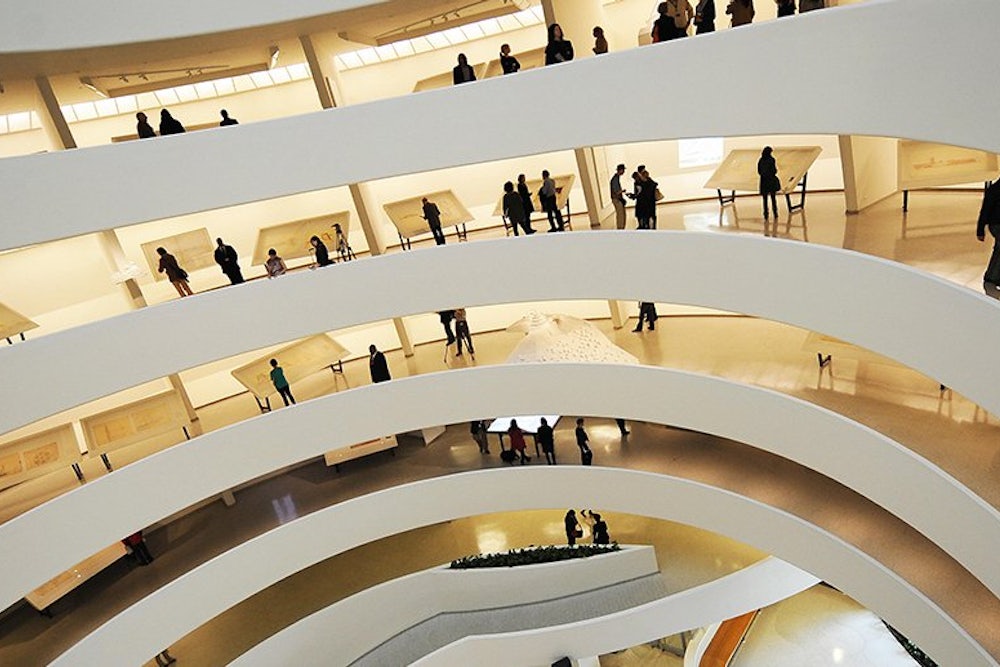The new Solomon R. Guggenheim Museum is Frank Lloyd Wright’s last public building and his only one in the city of New York. Originally commissioned more than fifteen years ago the building has been the subject of battles, arguments, whispering campaigns and shouted protests, ranging from a long but finally victorious engagement with the city’s building code to a formal document signed by most of the “New York” school of painters in which they pointed out that it was a farce to build a museum without consulting them.
Well, the building opened last week - in fact most of the week was spent in openings at the Guggenheim and a whole new status-stairway in New York is based on which opening you were invited to. James Johnson Sweeney, director of the Guggenheim, is to be envied for the space he has been given to work in; in the installation of his first show he has risen superbly to the challenge of the building, if challenge it is; he has made his own contribution to the building itself in the lighting arrangements; but above all he has shown off the suitability of the building for the general style of painting for which the Guggenheim is famous. The show is a success. The building is a beauty and don’t let anyone tell you different.
As you must know by now, Wright’s Guggenheim is a spiral ramp six stories high, about a third of a mile long, with a three percent grade and a diameter of 128 feet at the top, 100 feet at the bottom. It has been protested from the first that you can’t hang pictures decently for people to look at while they’re walking downhill; the opening show provides the answer: you can. Not only decently but brilliantly, thanks as much to Sweeney’s lights as to Wright’s design. The slight grade is a help to physical comfort; you take the elevator to the top ring and saunter down through the exhibition, gravity with you all the way. The ramp is divided into bays which break the fall without destroying the flow. The main ramp-wall turns out not to be there. The pictures are floated about four feet out from it, fixed each to a single steel rod. No frames are used; the edges of the paintings are white, the walls are white, the rods are white. Light comes through glass panels in such a manner that the paintings seem to rest on a bank of white light in which there is no glare at all. The light on the pictures is similar. The only museum lighting in the country that compares with this is that of the new wing in Cleveland where daylight and electric light are mixed. Here most of the light seems to be artificial, though Wright originally provided for daylight to come in through the line of the spiral. Anyway whether you look at the pictures before you or at those across the well, at least 100 feet away, the light itself is both fully adequate and cheerful.
It is already clear how the form of Wright’s building discharges the function of displaying pictures for exhibition. The great spiral is the only arrangement I’ve ever seen that lets you walk through an exhibition with no involuntary doubling back. But the building does something else, too, that is probably as important as the machine for-looking-at-pictures: it gives you the sheer elation that comes from looking at, being in and moving through large amounts of enclosed space. Although we stand as verticals on the horizontal earth, space enclosed by curved planes brings us more elation than space enclosed by vertical and horizontal planes. In this quality Wright’s Guggenheim is more closely related to its neighbor, the Metropolitan, and to the National Gallery in Washington, than to the Museum of Modern Art or the Whitney.
If you take New York painters as seriously as they take themselves, you can sympathize with their objections to all this handsome space. The exhibition begins with a large selection of Kandinskys from the museum’s unparalleled holdings and moves down the ramp of time through the development of nonobjective painting that followed Kandinsky. While this is the main line (it used to be the Museum of Non-Objective Painting) it is not held rigorously, thanks again to Sweeney, who, in his directorship, has vastly expanded the scope of the collection. There are paintings by Chagall and Cezanne, Braque and Picasso, quite a few by Klee and three by Modigliani, including a fine reclining nude. There is also sculpture now, with special strength in Brancusi.
But still the stress is Kandinsky and his children. Brooks, Kline, Sam Francis, Hartung, Mathieu, Pollock, Soulages and so many others. In the open setting of the great spiral these works lose all their seriousness and importance, both of which qualities are greatly enhanced by the small galleries of the Museum of Modern Art. The joy of spirit Kandisky is made evident and that spirit rolls downt he ramp engulfing younger men completely. Looking across the well you see one after another of the brightly colored adventures in paint and they all seem rather gay, charming in their childlike intensity.
In Wright’s great ramp, all the hokum about gesture and size, texture and space simply vanishes, lost in monumental space, obliterated by the gesture of a giant. You are looking at daubs and may like them or not with no reference at all to the rhetoric. It’s rather like art night at the PTA. You admire the boards Alberto has knocked together and the bravado with which little Georges has squirted colored toothpaste all over his picture. Antoni, the rascal, is still getting sand into his paints but he’s over his morbid fascination with black. You know that eventually the children will all grow up and some of them may even become artists; and you know that the teacher knows it, too.
